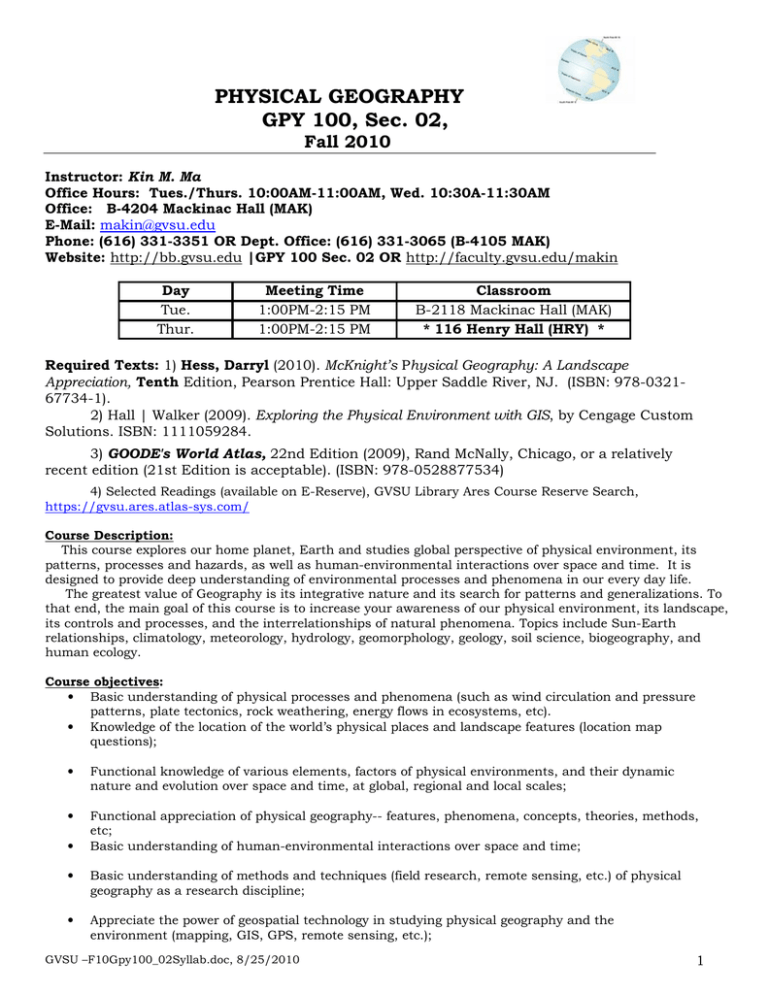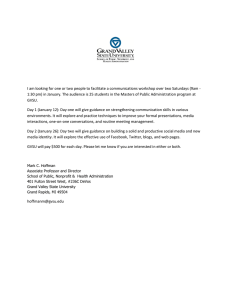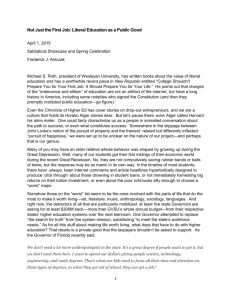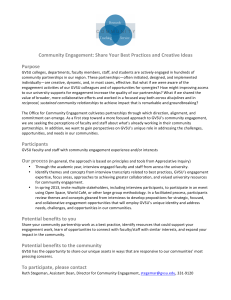
PHYSICAL GEOGRAPHY
GPY 100, Sec. 02,
Fall 2010
Instructor: Kin M. Ma
Office Hours: Tues./Thurs. 10:00AM-11:00AM, Wed. 10:30A-11:30AM
Office: B-4204 Mackinac Hall (MAK)
E-Mail: makin@gvsu.edu
Phone: (616) 331-3351 OR Dept. Office: (616) 331-3065 (B-4105 MAK)
Website: http://bb.gvsu.edu |GPY 100 Sec. 02 OR http://faculty.gvsu.edu/makin
Day
Tue.
Thur.
Meeting Time
1:00PM-2:15 PM
1:00PM-2:15 PM
Classroom
B-2118 Mackinac Hall (MAK)
* 116 Henry Hall (HRY) *
Required Texts: 1) Hess, Darryl (2010). McKnight’s Physical Geography: A Landscape
Appreciation, Tenth Edition, Pearson Prentice Hall: Upper Saddle River, NJ. (ISBN: 978-032167734-1).
2) Hall | Walker (2009). Exploring the Physical Environment with GIS, by Cengage Custom
Solutions. ISBN: 1111059284.
3) GOODE's World Atlas, 22nd Edition (2009), Rand McNally, Chicago, or a relatively
recent edition (21st Edition is acceptable). (ISBN: 978-0528877534)
4) Selected Readings (available on E-Reserve), GVSU Library Ares Course Reserve Search,
https://gvsu.ares.atlas-sys.com/
Course Description:
This course explores our home planet, Earth and studies global perspective of physical environment, its
patterns, processes and hazards, as well as human-environmental interactions over space and time. It is
designed to provide deep understanding of environmental processes and phenomena in our every day life.
The greatest value of Geography is its integrative nature and its search for patterns and generalizations. To
that end, the main goal of this course is to increase your awareness of our physical environment, its landscape,
its controls and processes, and the interrelationships of natural phenomena. Topics include Sun-Earth
relationships, climatology, meteorology, hydrology, geomorphology, geology, soil science, biogeography, and
human ecology.
Course objectives:
• Basic understanding of physical processes and phenomena (such as wind circulation and pressure
patterns, plate tectonics, rock weathering, energy flows in ecosystems, etc).
• Knowledge of the location of the world’s physical places and landscape features (location map
questions);
•
Functional knowledge of various elements, factors of physical environments, and their dynamic
nature and evolution over space and time, at global, regional and local scales;
•
Functional appreciation of physical geography-- features, phenomena, concepts, theories, methods,
etc;
Basic understanding of human-environmental interactions over space and time;
•
•
Basic understanding of methods and techniques (field research, remote sensing, etc.) of physical
geography as a research discipline;
•
Appreciate the power of geospatial technology in studying physical geography and the
environment (mapping, GIS, GPS, remote sensing, etc.);
GVSU –F10Gpy100_02Syllab.doc, 8/25/2010
1
•
•
Critical thinking, reading comprehension, writing, speaking, group interaction, and library research
skills. (Water Resource debate)
Ability to use the Internet as a global information resource.
My teaching philosophy:
I see my role as a facilitator of your learning and performance in this course. Availability, patience,
and fairness are the principal guidelines used in this course. Please note that the instructor cannot deliver
all of the information and knowledge that is needed. This course is a medium for learning physical
geography. This course is a partnership between the instructor and students--both have the responsibility
for your success.
Each student has the major responsibility for his/her education. Courses are delivered by
instructors and university; education is developed by the STUDENTS. It is the student's role to have
personal responsibility for learning and performance--learning the course material and achieving the
course objectives. Please note that lack of preparation on your part does not constitute an emergency on
the instructor's part.
Important Dates
Exam #1
Lab #1 DUE
Lab #2 DUE
Lab #3 DUE
Drop Deadline, 5:00PM
Exam #2
Lab #4 DUE
Classes End
Final Exam
Oct. 7
Oct. 12
Oct. 21
Oct. 28
Oct. 29, 5:00PM
Nov. 11
Nov. 16
Dec. 11
Mon., 12/13, 12:00P - 1:50PM
Course Grade Format
Item
Exam #1
Exam #2
Lab #1
Lab #2
Lab #3
Lab #4
Learning Outcome Report
Attendance/Participation
Debates
Final exam
Total
Percent
Points
18.3%
18.3%
14.7%
3.7%
3.7%
9.2%
3.7%
5.5%
4.6%
18.3%
100%
100
100
80
20
20
50
20
30
25
100
545
Exams, Labs, Participation:
Exam Structure:
Exams (100 points each) and Final Exam (100 points)
Multiple Choice / Fill in/ True/False Questions (2 pts. each)
4 Short Essay Questions
Exams
70 points
30 points
100 points
Map Questions:
To increase geographic knowledge of the world’s regions and places, each exam will have 4-5 map location
questions. Names and places and exam review guide will be provided a week before the exams.
GVSU –F10Gpy100_02Syllab.doc, 8/25/2010
2
Requests for exams at times other than regularly scheduled are strongly discouraged and will be granted
only for extreme emergencies (with proof required). Please contact me EARLY before a potential time conflict
so that we can make the proper arrangements.
Participation and Attendance: I believe in your commitment to the learning we share through dialogue
with each other. Attending class is essential to mastering and understanding the material in class. Class
Participation will be evaluated by in-class participation and/or also "significant dialogue" over e-mail. If you
are unable to attend class for an extended period, please notify me via e-mail or phone BEFORE the time
you will miss class. Attendance will be taken at each class session. During the semester, TWO unexcused
absences will be allowed WITHOUT penalty.
Debates: There will be two discussions/debates regarding current environmental/geographical issues (see
course outline). For/Against groups will be formed and participation is required. There will be instructor
evaluation of research preparation and debate performance. Preparation, and participation is worth 25 pts
for the semester. More details will be provided as the time draws near.
Lab Exercises:
Computer-based or field-based lab exercises are an excellent experiential learning tool.
Before submitting your lab report, please go over this checklist:
All lab reports should be submitted by the due date (see the dates on the syllabus and the chart above).
All lab reports must be typed (font 11 or 12, 1.5” spacing) and STAPLED (hand-written and unstapled
reports will not be accepted for grading).
All lab reports should have a cover page with the lab title, your name, course name and number
(GPY100_02) and the date. The size of each lab report is typically between 2 and 4 pages (1.5” spacing).
Please, make sure to answer ALL LAB questions formulated in the lab handouts.
All graphs and charts should be neat (either computed by Excel or similar software or neatly drawn by
hand). Please, use pencils and rulers if you need to submit a hand-drawn chart. Graphs should be well
stapled to the text of the report. I will NOT be responsible for any lost parts of unstapled reports.
If a lab exercise includes a blank map, it should be also stapled to the text. You can use only maps
provided in class (and extra maps are usually available outside my office).
Learning outcome report
Towards the end of the semester, you will also write a short report summarizing your learning outcomes.
Each student will write a learning outcome report summarizing what you have learned and what
instructional methods have helped you learn throughout the semester. The length of the report should be
no more than 5 pages if double spaced.
Late Exercises Policy
Only under extenuating circumstances will late lab exercises be accepted WITHOUT penalization. Official
proof with a doctor’s note would need to be provided. The price of a late lab exercise is 20% per day late.
Late exercises will NOT be accepted 3 days after the deadline. If you have an extenuating circumstance,
please come and discuss it with me, call me or e-mail me at makin@gvsu.edu BEFORE the deadline; the
earlier the better.
Course Withdrawal: Following GVSU guidelines, the Course Withdrawal Deadline (in order to receive
a grade of "W") is Friday, Oct. 29, 2010 at 5:00 PM.
Incomplete Grade Policy: An “I” grade may be given for student work that is lacking in quantity to meet
course objectives. It may be assigned when extenuating circumstances, such as illness, necessary absence,
or other reasons generally beyond the control of the student, prevent completion of the course
requirements at the end of the semester. This grade MAY NOT be given as a substitute for a failing grade
or withdrawal.
GVSU –F10Gpy100_02Syllab.doc, 8/25/2010
3
Course Grade Distribution
A
AB+
B
BC+
C
CD+
D
F
94-100 90-92.9 87-89.9 84-86.9 80-83.9 77-79.9 74-76.9 70-73.9 66-69.9 60-65.9 <60
Note: There are NO 'A+' NOR 'D-' grades.
Special Learning Challenges: Each student learns in his or her own way. If you have a disability that will
require special accommodations in this course, please contact the Disability Support Services (DSS) in
200 Student Services (STU) at (616)331-2490. The DSS will assist me in providing the necessary
accommodations in order to enhance the learning environment for you. If you have already done so, DSS
will provide you with a letter that describes your specific needs and the necessary accommodations. Please
bring that letter to my attention AS SOON AS POSSIBLE, and PRIOR to the date of the first exam.
Student Code and Plagiarism: According to GVSU's General Academic Policies, here are the stated
policies:
1. No student shall knowingly, without authorization, procure, provide, or accept any materials
which contain questions or answers to any examination or assignment;
2. No student shall, without authorization, complete, in part or in total, any examination or
assignment for another person;
3. No student shall, without authorization, allow any examination or assignment to be
completed, in part or in total, by another person;
4. No student shall knowingly plagiarize or copy the work of another person and submit it as his
or her own;
5. No student shall submit work that has been previously graded or is being submitted
concurrently to more than one course without authorization from the instructor(s) of the class(es)
to which the student wishes to submit it.
Course Websites
1) Course Website: http://bb.gvsu.edu (Blackboard site)
2) http://faculty.gvsu.edu/makin/gpy100/F10Gpy100_02Syllab.doc
Student Responsibilities:
Students are expected to attend lectures, complete lab assignements and take exams. I will present
information in class that is NOT in the required texts. Attendance will be checked weekly, since you need to
attend class regularly to participate. Note: Excessive absences will adversely affect the participation grade
(see below). Also check your e-mail at least once per day, since I may send you some information about an
interesting article or event that relates to the class. It is YOUR responsibility to check E-mail and keep
enough open disk space in your account, mail.GVSU.edu account. The instructor is NOT responsible for
bounced emails because of inaccurate or FULL email boxes.
Email
E-mail will be periodically sent to the entire class regarding items or class Powerpoint presentations that I
have posted to the Blackboard website. It is important that you are checking your GVSU Google e-mail
address you have been assigned REGULARLY. E-mail messages are sent to the CLASS and NOT to
individuals. I am NOT responsible if your e-mail account reaches the disk space limit and the messages I
send bounces. I CANNOT keep up with over 150 students and the potential bounce back of messages
because of specific problems. It is YOUR responsibility to manage your email account and allow enough
space for additional messages.
**Sending Email**
When writing email to the instructor, for easy identification of your name and your class section, in the
Subject Line of the messages, include the Class and Section Number. e.g., "Gpy100_02, 'Your topic.'
Always sign your FULL name at the end of your e-mail. Emails that DO NOT have my name and your name
will NOT be responded to.
GVSU –F10Gpy100_02Syllab.doc, 8/25/2010
4
Tentative Course Outline
Note: Contents of this syllabus may be modified by the instructor
in ways to best enhance your learning experience.
Anim: refers to on-line Web Animations on BB
Wk
1
Date
Topics
8/31, 9/2 Introduction to Course
Reading
Other/Assignment due
Ch. 1, 2
Part I: Intro to Physical Geography
1*
9/3,5:00pm,Add Deadline
Portraying Earth
2
9/7 Labor DAY (NO CLASSES)
2
9/9 Part II: Earth and Weather
Earth-Sun Geometry, Atmosphere,
3
4
9/14, 9/16 Part II: Earth and Weather
Earth-Sun Geometry, Atmosphere,
Global Energy Balance
9/21, 9/23 Atmospheric Pressure and Wind
5
Moisture, Global Circulation
9/28, Moisture in the Atmosphere
Ch. 6, 7
Humidity Calculation
5
9/30 Moisture in the Atmosphere
Ch. 6, 7
Computer Lab #1, Weather
6
10/5 Severe Weather, Hurricanes,
Ch. 7
Ch. 3
Ch. 4, 5
pp. 220--232
Ch. 5, 6
9/14,
Global Warming Disc. Begin
9/21, Global Warm Disc. Inclass
Lab #1 Pt. 1 Distrib.
Cyclones, El Nino
6
7
10/7 Exam #1
10/12 Part III: Climatology
10/14 climate zones
8
10/19, Soil Geography
10/21 Soils
9
Ch. 8
LabManual
10/26, 10/28 Biogeography
Chaps. 1-6
10/12 Lab #1 Due; Lab #2
Hall, Exer. 2.2 "Hurr. Georges"
10/21/2010, Lab #2 DUE
Ch. 12
Lab #3 (Soil FIELD sampling)
Ch. 10,11
Rainforest Video
Lab #3 Due (10/28)
Ch. 13
Ch. 14
LabManual
Mt. Pinatubo Video
Biosphere Cycles, Plant Geography
10/29,5:00P* Drop Deadline to get a 'W'
10
11/2, 11/4 Part VI: Geomorphology
Structure of Earth, Plate Tectonics,
11/4 Volcanoes
11
11/9 Volcanoes
11
11/11 Exam #2
12
11/16 Hydrosphere, Groundwater
Lab#4: Ex 2.4 (Plate Tectonics)
Ch. 14
Ch. 9, 16
Chaps. 7-8, 10-14
Water Questions Posting
Lab#4 DUE, 11/16
Ch. 16
Water Debate Prep
Water Resources Debate
Stream systems, processes
11/18
13
11/23 Groundwater
13
11/25 Thanksgiving (NO CLASSES)
14
11/30 Weathering/Mass Movements
14
15
12/2 Eolian Processes and landforms
12/7,12/9 Glacial and Coastal Processes
Ch. 15
Ch. 18
Desert Biomes Video
Ch. 19, 20
Evaluation
16
12/13 FINAL EXAM, B-2118 MAK
GVSU –F10Gpy100_02Syllab.doc, 8/25/2010
2:00-3:50PM Chaps. 9,15-16,18-20
5




